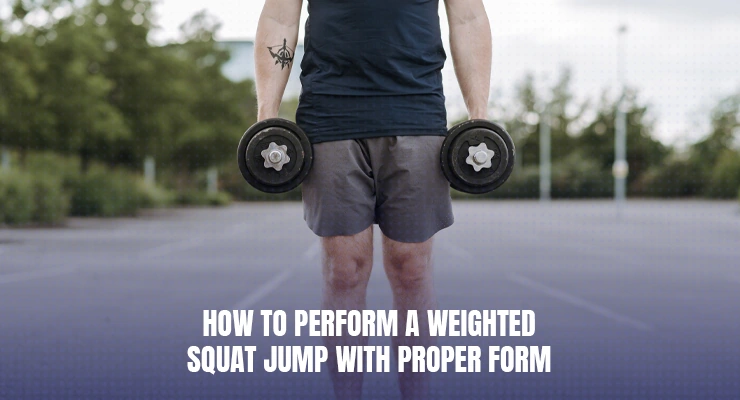
Are you looking to improve your athletic performance and take your explosive power to the next level? Look no further than the weighted squat jump. This compound exercise is a favorite among athletes and fitness enthusiasts alike, as it targets multiple testosterone sustanon 250 muscle groups while also improving explosive power and overall strength. In this blog post, we will explore the benefits of the weighted squat jump, how to perform the exercise correctly, and how to incorporate it into your training routine.
But first, let's talk about explosive power. Explosive power is the ability to generate maximal force in a short amount of time, which is critical for many sports and activities, such as basketball, volleyball, and sprinting. Research has shown that incorporating explosive exercises like the weighted squat jump into your training routine can improve not only your explosive power but also your overall strength and athletic performance. So, if you're looking to take your game to the next level or simply improve your fitness, keep reading to learn more about the weighted squat jump and how it can help you maximize your explosiveness.
What is the Weighted Squat Jump and How Does it Work?
The weighted squat jump is a compound exercise that involves adding resistance to a traditional squat jump. The resistance can come from a barbell, dumbbells, kettlebells, or any other weight-bearing object. The exercise is performed by descending into a squat position with the weight, then exploding upwards and jumping as high as possible while still holding onto the weight.
The weighted squat jump works by targeting multiple muscle groups at once, including the best pct cycle to keep gains quads, glutes, hamstrings, and calves, while also improving explosive power and overall strength. By adding resistance to the squat jump, the exercise becomes more challenging and requires greater force production from the muscles, resulting in increased power and explosiveness. Additionally, the jump component of the exercise adds a plyometric element, which further enhances explosiveness and can improve athletic performance in sports that require jumping or explosive movements.
Read about: Bo Jackson Workout
Benefits of Incorporating Weighted Squat Jumps into Your Training
Incorporating weighted squat jumps into your training routine can offer a variety of benefits for your overall fitness and athletic performance. Here are some of the key benefits:
- Improves Explosive Power: The explosive nature of the weighted squat jump helps to develop and enhance your ability to generate maximal force in a short amount of time. This is crucial for sports that require sudden bursts of energy, such as sprinting, jumping, or throwing.
- Builds Lower Body Strength: Weighted squat jumps are a compound exercise that engages multiple lower body muscles, including the quadriceps, glutes, hamstrings, and calves. By training these muscles simultaneously, you can build strength and power in your lower body.
- Enhances Athletic Performance: The improved explosive power and lower body strength gained from weighted squat jumps can lead to enhanced athletic performance in a variety of sports, including basketball, volleyball, and football, among others.
- Burns Calories: The explosive nature of weighted squat jumps makes them an effective calorie-burning exercise. By incorporating them into your training routine, you can burn more calories and potentially lose weight or maintain a healthy body composition.
- Offers Variety: Weighted squat jumps can be performed with a variety of equipment, including barbells, dumbbells, and kettlebells. Additionally, there are many variations of the exercise, such as single-leg weighted squat jumps, that can help to keep your workouts fresh and challenging.
How to Perform a Weighted Squat Jump with Proper Form

Performing a weighted squat jump with proper form is crucial to avoid injury and maximize the exercise's benefits. Here are the steps to perform the exercise correctly:
- Start by standing with your feet shoulder-width apart and holding the weight at chest height, with your elbows tucked in.
- Lower your body into a squat position, keeping your chest up and your knees tracking over your toes. Your thighs should be parallel to the ground, and your weight should be evenly distributed across your feet.
- Explosively drive through your feet, pushing your body up and off the ground while simultaneously pressing the weight overhead. Your arms should fully extend above your head, and your body should reach full extension at the top of the jump.
- Land softly and absorb the impact by bending your knees and hips, returning to the squat position. Be sure to land on the balls of your feet and avoid letting your heels touch the ground.
- Repeat the movement for your desired number of reps or time.
Some additional tips for performing the weighted squat sustanon 250 results jump with proper form include:
- Keep your core engaged throughout the movement to maintain stability and avoid excessive stress on your lower back.
- Keep your gaze forward and avoid looking down or up during the exercise.
- Start with a light weight and gradually increase the weight as you become more comfortable with the movement.
Precautions and Safety Tips for Weighted Squat Jumps
While weighted squat jumps can be a highly effective exercise for building explosive power and lower body strength, it's important to take proper precautions to avoid injury. Here are some precautions and safety tips to keep in mind:
- Start with a Light Weight: Begin with a light weight and gradually increase the weight as you become more comfortable with the movement. Overloading the weight too soon can increase the risk of injury.
- Maintain Proper Form: Keep your knees tracking over your toes and your chest up throughout the exercise. Avoid letting your knees cave in or leaning forward excessively.
- Land Softly: To minimize the impact on your joints, land softly on the balls of your feet and avoid letting your heels hit the ground.
- Avoid Overuse: While weighted squat jumps can be highly effective, it's important not to overdo it. Incorporate them into your routine in moderation and allow your muscles time to rest and recover.
- Consult with a Trainer: If you're new to weighted squat jumps or have any concerns about performing the exercise safely, consider consulting with a certified trainer or fitness professional. They can provide guidance on proper form and modifications to make the exercise more manageable.
By taking these precautions and safety tips into account, you can safely incorporate weighted squat jumps into your training routine and reap the benefits of improved explosive power and lower body strength.
Increasing Explosiveness: How Weighted Squat Jumps Can Help
If you're looking to increase your explosiveness, adding weighted squat jumps to your training routine can be highly beneficial. Here are some ways weighted squat jumps can help increase explosiveness:
- Increases Power Output: Explosive movements like weighted squat jumps require your muscles to produce maximal force in a short amount of time. By training your muscles to generate greater power, you can increase your overall explosiveness.
- Develops Fast-Twitch Muscle Fibers: Fast-twitch muscle fibers are responsible for producing quick, explosive movements. Weighted squat jumps can help to develop and strengthen these fibers, leading to increased explosiveness.
- Enhances Coordination: The weighted squat jump is a complex movement that requires coordination between multiple muscle groups. By improving your coordination, you can improve your ability to execute explosive movements with greater speed and efficiency.
- Provides a Plyometric Effect: Plyometric exercises like weighted squat jumps involve rapid, explosive movements followed by quick deceleration. This plyometric effect can help to increase explosiveness by improving the muscle's ability to generate maximal force quickly.
By incorporating weighted squat jumps into your training routine, you can improve your explosiveness, leading to enhanced athletic performance in a variety of sports and activities.
Variations of the Weighted Squat Jump for Different Goals

There are several variations of the weighted squat jump that can be used to achieve different fitness goals. Here are some variations of the exercise and how they can be used:
- Single-Leg Weighted Squat Jumps: This variation involves performing the weighted squat jump on one leg at a time. This variation can help to improve balance, stability, and unilateral lower body strength.
- Depth Jump Squat: In this variation, you begin by standing on an elevated surface, such as a plyo box, and jumping off the surface before performing a weighted squat jump. This variation can help to improve explosive power and increase the plyometric effect of the exercise.
- Barbell Front Squat Jump: This variation involves holding a barbell across the front of your shoulders while performing the weighted squat jump. This variation can help to improve upper body strength and stability while still targeting the lower body muscles.
- Dumbbell Goblet Squat Jump: In this variation, you hold a dumbbell vertically in front of your chest while performing the weighted squat jump. This variation can help to improve core stability and upper body strength while targeting the lower body muscles.
- Weighted Split Squat Jumps: This variation involves performing the weighted squat jump with one foot in front of the other, similar to a lunge position. This variation can help to improve unilateral lower body strength and balance.
Incorporating variations of the weighted squat jump into your training routine can help you achieve your fitness goals and provide a fresh challenge to your workouts.
Best Practices for Incorporating Weighted Squat Jumps into Your Routine
To get the most out of your weighted squat jump training, it's important to incorporate best practices into your routine. Here are some tips to help you do just that:
- Warm-up Properly: Before performing any weighted squat jumps, make sure to properly warm up your lower body muscles. This can include a dynamic warm-up routine or a few sets of bodyweight squats.
- Start with Light Weights: If you're new to weighted squat jumps, start with light weights and gradually increase the resistance as you become more comfortable with the movement.
- Use Proper Form: Maintaining proper form throughout the exercise is crucial for both maximizing results and avoiding injury. Keep your knees tracking over your toes and your chest up throughout the movement.
- Vary Your Sets and Reps: To challenge your muscles and prevent boredom, vary your sets and reps. For example, you can perform 3-4 sets of 5-6 reps or 2-3 sets of 10-12 reps.
- Incorporate into a Balanced Routine: While weighted squat jumps can be highly effective, they shouldn't be the only exercise in your routine. Incorporate them into a balanced routine that also includes other compound exercises, such as deadlifts and lunges, as well as cardiovascular exercise.
- Allow for Rest and Recovery: Like any exercise, weighted squat jumps require rest and recovery. Allow your muscles at least 24-48 hours of rest before performing the exercise again.
By incorporating these best practices into your weighted squat jump routine, you can improve your explosiveness, lower body strength, and overall fitness while minimizing the risk of injury.
